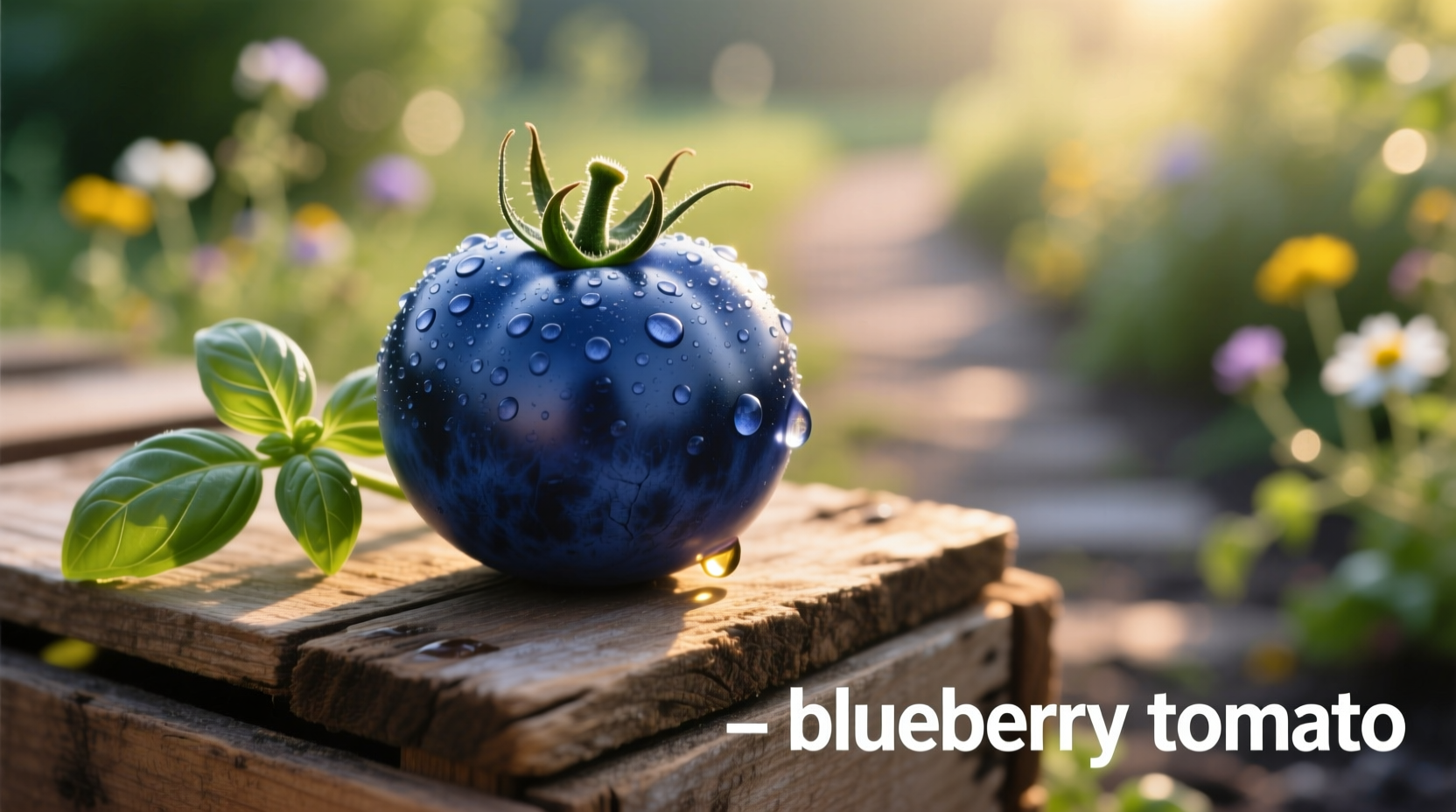Blueberry tomatoes are not related to blueberries at all—they're a unique heirloom tomato variety known for their deep purple-black color and sweet, complex flavor profile. Despite the confusing name, these tomatoes contain anthocyanins (the same pigments found in blueberries) which give them their distinctive color and added antioxidant benefits.
Confused by the name blueberry tomato? You're not alone. Many gardeners and food enthusiasts mistakenly believe these are some hybrid between tomatoes and blueberries. Let's clear up the confusion and explore everything you need to know about this remarkable heirloom variety that's gaining popularity among home growers and chefs alike.
What Exactly Is a Blueberry Tomato?
The blueberry tomato (Solanum lycopersicum 'Blueberry') is a specialty heirloom variety developed through selective breeding, not genetic modification. Its name comes from its deep purple-to-black skin coloration—reminiscent of blueberries—caused by anthocyanin pigments. These tomatoes typically weigh 4-8 ounces and have a rich, complex flavor profile that combines sweetness with earthy undertones.
| Characteristic | Blueberry Tomato | Standard Red Tomato |
|---|---|---|
| Color | Deep purple-black (with possible green shoulders) | Bright red when ripe |
| Flavor Profile | Sweet with earthy, complex notes | Balanced sweet-tart |
| Key Nutrients | Anthocyanins, lycopene, vitamin C | Lycopene, vitamin C |
| Days to Maturity | 75-85 days | 60-80 days |
Why the Confusing Name?
The "blueberry" in blueberry tomato refers solely to its coloration, not botanical relationship. According to research from the University of California's Agricultural and Natural Resources department, this variety was developed through traditional breeding techniques that activated anthocyanin production in the fruit's skin—a trait found in some wild tomato relatives but typically bred out of commercial varieties.

From Breeding Project to Garden Favorite: A Timeline
The development of blueberry tomatoes represents decades of selective breeding work:
- 1990s: Russian botanists first documented tomatoes with purple coloration in wild Solanum species
- Early 2000s: Oregon plant breeder Tom Wagner began crossing wild tomatoes with cultivated varieties
- 2005: First stable "Indigo Rose" variety released by Oregon State University
- 2010s: "Blueberry" and similar anthocyanin-rich varieties became available to home gardeners
- Present: Multiple purple tomato varieties now available, each with unique flavor profiles
Growing Blueberry Tomatoes: What You Need to Know
Successfully growing blueberry tomatoes requires understanding their specific needs:
Climate Requirements
These tomatoes thrive in warm climates with plenty of sunlight—similar to standard tomatoes. However, the anthocyanin production (that beautiful purple color) increases with more sun exposure. According to Cornell University's gardening resources, they perform best in USDA hardiness zones 5-10 with at least 6-8 hours of direct sunlight daily.
Soil and Watering Needs
Like all tomatoes, blueberry varieties prefer well-draining soil with a pH between 6.2-6.8. What's unique is their response to consistent moisture—irregular watering can cause cracking in these thin-skinned fruits. The University of Vermont Extension recommends mulching heavily to maintain consistent soil moisture.
When to Harvest
Don't wait for blueberry tomatoes to turn completely red like standard varieties. Harvest when they develop their characteristic deep purple color with possible red blush on the bottom. The Oregon State University Extension notes that these tomatoes continue ripening after picking, so harvest when they give slightly to gentle pressure.
Culinary Applications: Beyond the Salad Bowl
Blueberry tomatoes offer unique culinary possibilities thanks to their complex flavor profile:
Raw Applications
Their sweet-earthy flavor shines in:
- Caprese salads with fresh mozzarella and basil
- Salsas that benefit from complex sweetness
- As a colorful garnish for cheese boards
Cooked Preparations
When cooked, blueberry tomatoes develop deeper umami notes:
- Roasted with olive oil and herbs as a side dish
- Blended into sauces for added complexity
- Pickled for a unique condiment
Nutritional Benefits: More Than Just Good Looks
Research published in the Journal of Agricultural and Food Chemistry confirms that anthocyanin-rich tomatoes like the blueberry variety offer enhanced nutritional profiles:
- Double antioxidant capacity compared to standard red tomatoes
- Anthocyanins associated with reduced inflammation and cardiovascular benefits
- Lycopene content remains high despite the color variation
Important note: The anthocyanins are primarily in the skin, so eating these tomatoes with the skin on maximizes nutritional benefits.
Common Growing Challenges and Solutions
While rewarding, blueberry tomatoes present some unique challenges:
Color Confusion
Many gardeners mistakenly think their tomatoes aren't ripe when they remain purple. Remember—they won't turn fully red like standard varieties. Harvest when deeply colored with slight softness.
Sunscald Risk
Their dark color makes them more susceptible to sunscald in extremely hot climates. The University of Maryland Extension recommends providing afternoon shade in regions with intense summer heat.
Disease Susceptibility
Like many heirloom varieties, blueberry tomatoes can be more susceptible to common tomato diseases. Implement crop rotation and proper spacing (24-36 inches between plants) to minimize risk.
Where to Find Blueberry Tomato Seeds or Plants
These specialty tomatoes are increasingly available through:
- Specialty seed companies (look for varieties like 'Indigo Rose,' 'Blue Beauty,' or 'Black Beauty')
- Local farmers markets (particularly those featuring heirloom varieties)
- Online seed retailers with heirloom selections
When purchasing seeds, verify they're from reputable sources—some sellers mislabel standard purple tomatoes as "blueberry" varieties. True blueberry tomatoes should have documented breeding history and specific growing requirements.
Final Thoughts for Gardeners and Food Lovers
Blueberry tomatoes offer a delightful combination of visual appeal, complex flavor, and enhanced nutrition. While they require similar care to standard tomatoes with a few special considerations, their unique characteristics make them worth the effort for home gardeners seeking something beyond ordinary varieties. Whether you're growing them for their striking appearance, nutritional benefits, or culinary versatility, these purple gems can add something special to your garden and kitchen.











 浙公网安备
33010002000092号
浙公网安备
33010002000092号 浙B2-20120091-4
浙B2-20120091-4